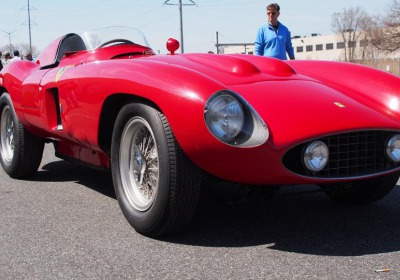The Ferrari 250 GTO and TR
Mon, 28 Apr 2014
Sitting in a line under the unforgiving rays of the sun was an astonishing sight: A 375MM Ferrari followed by a four-cylinder Ferrari 875 and three of the most famous cars of all: A 250TR, 250GTO and a 250LM, the last car to win Le Mans for Ferrari. They were not roped off, and the enthusiastic but respectful attendees were free to get as close as they wanted to better admire and take photographs of them. But this was only the beginning.
Enzo Ferrari was notably indifferent to the aesthetics of his competition cars and rather more interested in the engineering under the hood. Yet some of the world’s most beautiful cars were created under his direction.
Many of the greatest competition sports cars ever made are part of the collection on display at the Simeone Foundation in Philadelphia. A Daytona Cobra sits near a Porsche 917K, alongside Ford GT 40s, a worthy competitor among the likes of Alfa Romeo and, of course, Ferraris. Fred is incredibly passionate about these cars, so naturally he has become extremely knowledgeable.
Every great car collection shares one problem, however: Cars are meant to be mobile, to be seen and heard in action. Like wildcats at a zoo, it’s upsetting to see them confined rather in than thriving in their natural habitats.
Dr. Fred Simeone understood this very well when he established the museum for his superb collection. And so it began, a program held during the warmer months of the year, where cars were brought out and run in the expansive paved area behind the Foundation building.
This was the day we were going to see these cars run. The Foundation owned two of the cars; the rest belonged to other private owners. We got to take it all in and see them in action. We were allowed to hear the sound of the big four-cylinders against the rumble of the V12s. Coming across any of these cars is uncommon, but to see them all together is a rare privilege.
The four-cylinder 875 is pretty, almost delicate and quite the juxtaposition next to the more muscular 375MM, a car that had a short production life. The three V12s are some of the most relevant in Ferrari history, with the 250 GTO being perhaps the most famous, particularly for continually setting auction records.
The Testarossa is exquisite, like a cheetah, not an ounce of extra weight. It has perfect lines and clearly built purpose. It gives the illusion of movement even when it stands completely still and silent. Looking at it closely, the panel gaps on the tiny unlined doors are wide enough to see daylight through, and it has a delightful patina. It was built for speed, not show, not comfort.
These street-legal cars were from the golden age of sports-car racing. They are virtuoso examples of hand-built, purely mechanical cars. Their beauty continues under the hood with the engines, which are works of art in themselves. Built long before the alphabet soup of modern electronics, ECUs, ABS, PAS, crumple zones, five-point harnesses, airbags—even disk brakes in some cases. These cars required a talented driver behind the wheel.
The 875 is the first to start, its four huge cylinders being quite lumpy on idle. All at once, the smell brings back memories of races of long ago. Next up is the 375MM, a much more powerful and muscular-looking car. It’s a smoother but more aggressive sound. The cars drive around the tarmac, with the sounds of the engines echoing off the building.
Fred Simeone jumps into the TR; with a crackle, the V12 bursts into song. It is utterly sinuous as it circles. Seeing it here today, I am filled with admiration for the drivers who won the Le Mans 24 with such little protection.
Finally, the 250LM pulls out. The LM is more purposeful than beautiful, but it’s still impossible to look away from.
The day comes to a close as the cars bask in the sun. All is quiet again. There is no hurry to disperse as Fred, the volunteers and private owners remain. Simeone mingles, happy to discuss the cars and talk to the enthusiasts. They have provided a very rare opportunity, all for less than the price of a movie. For just a mere $12, you can see these cars as well as the entire collection on display in the museum, quite possibly the best automotive bargain I can think of.
By Ronan McGrath



